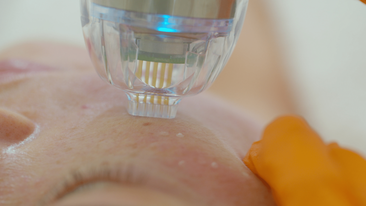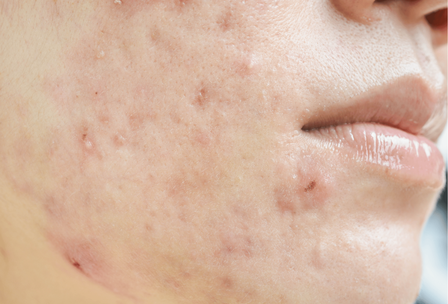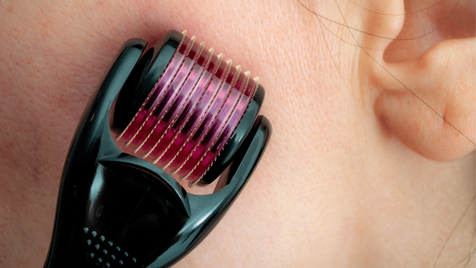Microneedling For Acne Scars: Is This The Best Solution?

Are you one of the 1%?
According to the American Academy of Dermatology (AAD) Association, “acne is the most common skin condition in the United States.” We all get it at some point, and there is about a 90% possibility that a teenager will have acne that persists until adulthood. Even when the acne clears, some of those people – about 1% – are likely to develop severe acne scars. Because of the frequency of acne and acne scars, we’ve seen a lot of treatment options created over the years, some more effective than others. Microneedling for acne scars is one of the most promising.
What are acne scars, and why do acne scars form?
Acne happens when our pores are filled with dirt, oil, and bacteria, causing different kinds of bumps, blemishes, and lesions. Acne scars are the result of swollen acne blemishes. Once the acne pore swells, it causes a break in the follicle wall, creating acne blemishes. Some of these breaks are small, and their scars are shallow that tend to heal quickly. However, some damage even the surrounding tissue, causing deeper scars. The skin still attempts to repair these by forming new collagen fibers; however, the result is no longer as smooth and flawless. Hence, the acne scars.
As mentioned, not everyone gets acne scars. Most cases happen when someone has inflammatory acne; the red, swollen, and tender kind. Inflammatory acne damages the skin beyond common blackheads or whiteheads. If you start to pick or pop inflamed acne or don’t treat it in time, you’ll be more likely to develop scars. There may be some genetic links as a family member may have acne scarring.
Types of acne scars

If you come to us for help with your acne scars, you’re probably dealing with two types: atrophic or depressed scarring and hypertrophic or keloid scarring. The atrophic type has further sub-types. It is more likely that you have more than one type of scar as acne scars usually develop in a combination of two or more (sub)types.
Atrophic or Depressed scarring
Atrophic acne develops when there is lost tissue as a result of acne scarring. You’ll likely have one or more of the following:
- Ice pick scars have a cone-like shape that narrows to a point deep in the skin. These are common on the cheeks.
- Boxcar Scars have a square shape with sharp edges.
- Rolling scars are broad depressions in the lower cheek or jaw with sloping edges.
These scars could be challenging to remove and often need multiple treatment sessions over an extended time.
Hypertrophic or Keloid scarring
Keloid scarring develops from an overproduction of collagen when the skin is trying to repair itself from inflamed acne. These scars are mass of raised tissue typically found on the chest, back, shoulders, and jawline.
What are the treatment options for acne scars?
If you think acne breakouts are already frustrating, acne scars present even more problems. The good thing is, there are a lot of treatment options for acne scars. There are treatments that can be done at home and others that need to be performed in a clinic by your trusted dermatologist. Regardless of the type of treatment, it’s best to consult your dermatologist to help you decide on the best method for your skin.
At-home treatments
To treat acne scars at home, your dermatologist may recommend products that contain one or a combination of the following: Alpha hydroxy acids, lactic acid, retinoids, or salicylic acid. While over-the-counter acne products contain these ingredients, the concentration may not be enough to address those scars. Prescription medication, when applied consistently, can help you get your acne scars under control.
In-office procedures
If none of the at-home treatments seem to lessen your acne scars or speed up the healing process, there are a few in-office procedures that can help. This includes microdermabrasion, chemical peels, laser resurfacing, fillers, injections, subcision, and microneedling. When it comes to selecting the best option, there are many factors like price, skin sensitivity, your specific skin type and tone, availability of the procedure, and so on. We’ve found that microneedling for acne scars is one of the most effective, non-invasive options available.
What is microneedling?
Microneedling is a skin procedure that uses a small, handheld device to prick the skin with tiny, sterilized needles. Pricking the skin sounds counterproductive to scars, but it isn’t. The action stimulates the production of collagen, which can help with new tissue growth and healing. Aside from acne scars, it’s great for fine lines, wrinkles, and even enlarged pores. Microneedling is becoming more popular than other procedures because of the cost, safety, and effectiveness. Common names include skin needling, collagen induction therapy (CIT), and percutaneous collagen induction (PCI).
The Science behind Microneedling – What are the benefits?
With microneedling, the device pricks the skin with tiny, sterilized needles at depths of 0.5mm to 1mm. The small wounds created are intended to trigger the skin to produce collagen to heal these wounds. Collagen then helps make the skin smoother and firmer. As such, it is one of the recommended treatments by the AAD for depressed acne scars or those that result from lost tissue. However, it should be noted that it is not recommended for hypertrophic scars since there is excess collagen already.
What are the side effects?
Microneedling is relatively safer and less invasive compared to other in-office treatments for acne scars. However, as with all other procedures, it still has some side effects – the most common of which is minor skin irritation. You would also observe some redness for the next few days. More severe side effects are bleeding, bruising, infection, and peeling. Some darker skin types are more prone to discoloration, or hyperpigmentation. That’s why it’s important that your dermatologist understands how to best use microneedling in all skin tones. If you experience any of these side effects, there are some at-home solutions your dermatologist can recommend, so don’t hesitate to reach out.
At-home vs. Dermatologist microneedling
Are you interested in trying microneedling for acne scars? Here’s more good news; you actually have a choice whether to DIY (do-it-yourself) or have a dermatologist perform the microneedling procedure.
At-home microneedling or Dermarolling

‘At-home microneedling’ is actually a common beauty practice that can be traced back several decades. A derma roller is a simple device with a handle on one end and a roller with numerous fine, tiny needles on the other. This particular device was first used in 2005, although the studies on using needles to treat scar tissue go as far back as the 1990s. Now, there are a lot of derma rollers from different brands, and they are pretty affordable and easy to use.
After sterilizing the needles and preparing the skin, you just need to roll them over the sections of your skin that you wish to treat. However, regardless of the brand of derma roller you choose, you are still likely to damage your skin if you fail to do the procedure properly. And, even as you do it correctly, you still won’t get the same results as a professional.
There is one big drawback. Derma rollers can only treat superficial blemishes and scars. So if you’re looking for a solution for deep atrophic scars, you’ll need to call in the big guns.
Dermatologist microneedling
Your dermatologist can use a special, electronic microneedling device to address those deep scars that have plagued you for years. The machine can manage the depth of the needle and provides some other helpful options. You will need at least 3 to 4 sessions if you have moderate acne scars and as many as eight sessions if the scars are severe.
Microneedling done by a dermatologist is considered a cosmetic procedure, so it is not covered by insurance. The cost varies depending on your provider, their location, and if they are a microneedling expert. In addition to acne scars, your dermatologist can address wrinkles, fine lines, and pigmentation.
Platelet-rich plasma (PRP) addition
To make microneedling more effective, your dermatologist may suggest adding Platelet-rich plasma. With PRP, your dermatologist takes a blood sample and spins it through a special device called a centrifuge. This separates the plasma from the red blood cells. Plasma contains platelets and growth factors that your body use to heal. When added to microneedling, the PRP generates better results and improves the healing process.
The radiofrequency (RF) addition
Your dermatologist’s microneedling device may have a radiofrequency (RF) option. After the needles penetrate the skin, the device sends radio waves deeper into the skin, causing more collagen stimulation. The RF waves increase the effectiveness of microneedling. Your doctor can combine all three options (Microneedling, RF, PRP) for the best results possible.
How do you prepare for a microneedling session?
If you have a microneedling appointment, there are a few steps you should take beforehand.
- In the week leading up to your appointment, limit your alcohol intake, avoid anything that can delay healing.
- More so, 24 hours prior to your appointment, avoid excessive sun exposure to the sun.
- Lastly, before going to the clinic, your face should be clean and bare.
Your dermatologist will provide you with these details during your initial consultation and leading up to your appointment. The procedure takes about 30 to 60 minutes. You will feel discomfort; however, your dermatologist will apply a numbing agent before proceeding.
What to expect after microneedling at the dermatologist?
After the microneedling procedure, most people don’t need recovery time. The procedure is non-invasive, so you can continue with your normal daily activities. However, you may feel some irritation brought by the tiny injuries caused by the needles. There may also be some redness. Your dermatologist will recommend that you apply sunscreen or avoid the sun for a short period since your skin will be highly sensitive. You will see some results after a few weeks. But, to maintain these results and achieve your desired skin, you will need several sessions.
How often should you microneedle for acne scars?
Generally, microneedling should be done not more than once a month. This works best as, on average, it takes about 4-6 weeks for the surface skin cells to turn over. You can still discuss the most suitable frequency for your skin with your dermatologist.
When is microneedling not advisable?
If you are currently experiencing an acne breakout, your doctor will advise you to postpone the procedure until your acne clears. Microneedling is not recommended for those who are pregnant, have open wounds, have active skin inflammation like with psoriasis or eczema, had radiation therapy recently, or scars easily.
Is it the best solution compared to other acne scar treatments?
Microneedling for acne scars has a high success and satisfaction rate. It is one of the best solutions for scarring after the active acne has improved with medication. It uses the body’s natural healing abilities, making it one of the safest options as well. Microneedling is also less painful, with a similar satisfaction rate when compared to laser therapy.
Indeed, it is one of the best options available. However, your dermatologist has other acne-fighting options in their toolkit. They will provide guidance on the procedure that’s right for you.
Get expert help today.
At Eternal Dermatology in the DC area, we understand the social and psychological impact of acne scars. With our “microneedling for acne scars regimen,” we ensure that you get that added empathy and personal touch.
For a consultation, call 301-679-5772, or you can book an appointment online. Our lead dermatologist, Dr. Ife Rodney, is a board-certified dermatologist and dermatopathologist. She is an expert in skincare, anti-aging, and skin rejuvenation for all skin types.
Eternal Dermatology is conveniently located in Fulton, MD, and serves Clarksville, Columbia, Washington DC, Baltimore, Ellicott City, Laurel, Bowie, Silver Spring, and Howard County. We can’t wait to help you get your acne scars under control.
